Oklahoma Sooners - 1889
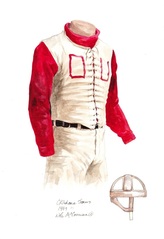
This painting honors the 1899 University of Oklahoma football team and their 5th season of competition. Coached by Vernon (V.L.) Parrington and captained by C.C. Roberts, the 1899 team went 2-1, outscoring their opponents 67-12.
oklahoma sooners - 1904
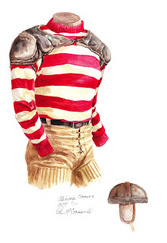
This painting honors the 1904 University of Oklahoma football team. Coached by Fred Ewing and captained by Byrom McCreary, the 1904 team went 4-3-1, outscoring their opponents 204-90 - including an impressive 75-0 victory against Oklahoma State.
Oklahoma Sooners - 1915
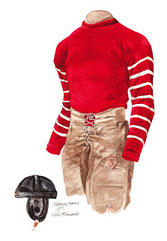
This painting honors the 1915 University of Oklahoma football team. Coached by Sooner icon Bennie Owen and captained by Forest Geyer, the 1915 team went an undefeated 10-0, outscoring their opponents 370-54 - including a 102-0 drubbing of NW Oklahoma.
Oklahoma sooners - 1929
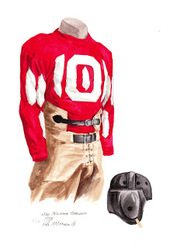
This painting honors the 1929 University of Oklahoma football team. Coached by the 7th coach in Sooners’ history - Adrian "AD" Lindsey - and captained by Frank Crider, the 1929 team went 3-3-2.
oklahoma sooners - 1932
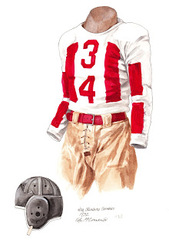
The 1932 Sooners went 4-4-1 in their conference, which was then known as the Big 6. The team was coached by first year coach Lewie Hardage who coached at Oklahoma for three seasons from 1932-34 and compiled a lifetime record of 11-12-4.
oklahoma sooners - 1938
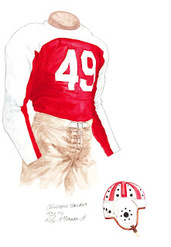
This painting honors the 1938 University of Oklahoma football team and #49, worn by Roland Young. Coached by Tom Stidham and co-captained by Gene Corrotto, Fort Smith and Earl Crowder, the 1938 team went 10-1, outscoring their opponents
185-29.
185-29.
oklahoma sooners - 1939
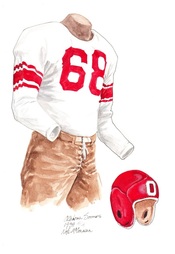
This painting honors the 1939 University of Oklahoma football team and #68, worn by Frank Ivy. Coached by Tom Stidham and captained by Norval Locke, the 1939 team went 6-2-1, outscoring their opponents 186-62.
Frank Ivy, also known as "Pop" (due to premature baldness), was an ‘iron man’ for the University of Oklahoma - playing on both sides of the ball. He was considered a strong pass rusher on defense, but earned All-American honors on the offensive side as a Wide Receiver. Following his career at the University of Oklahoma, Pop was drafted by the Pittsburgh Steelers in the 1940 draft, but was subsequently traded to the Chicago Cardinals during his first season. He served his country in World War II, missing the entire 1943-44 seasons, before returning to the Cardinals in 1945 once the war ended. He finished his NFL playing career in 1947, contributing to the franchise’s only championship title.
Ivy would return to his alma mater in 1948, entering the coaching ranks and assisting Bud Wilkinson - helping lead the Sooners to a 1950 National Championship. In 1954, Pop migrated to the Canadian Football League (CFL), where he would serve as head coach for the Edmonton Eskimos - leading them to 3 Grey Cup Championships. Over the next 30 years, until his retirement in 1984, Pop was involved with numerous NFL, CFL and AFL franchises as either a coach, assistant coach or scout. His teams included the Chicago Cardinals (NFL), British Columbia Lions (CFL), Denver Broncos (AFL), Houston Oilers (AFL) and the New York Giants (NFL). He is the only person to ever serve as a Head Coach in the National Football League, American Football League and the Canadian Football League.
Frank Ivy, also known as "Pop" (due to premature baldness), was an ‘iron man’ for the University of Oklahoma - playing on both sides of the ball. He was considered a strong pass rusher on defense, but earned All-American honors on the offensive side as a Wide Receiver. Following his career at the University of Oklahoma, Pop was drafted by the Pittsburgh Steelers in the 1940 draft, but was subsequently traded to the Chicago Cardinals during his first season. He served his country in World War II, missing the entire 1943-44 seasons, before returning to the Cardinals in 1945 once the war ended. He finished his NFL playing career in 1947, contributing to the franchise’s only championship title.
Ivy would return to his alma mater in 1948, entering the coaching ranks and assisting Bud Wilkinson - helping lead the Sooners to a 1950 National Championship. In 1954, Pop migrated to the Canadian Football League (CFL), where he would serve as head coach for the Edmonton Eskimos - leading them to 3 Grey Cup Championships. Over the next 30 years, until his retirement in 1984, Pop was involved with numerous NFL, CFL and AFL franchises as either a coach, assistant coach or scout. His teams included the Chicago Cardinals (NFL), British Columbia Lions (CFL), Denver Broncos (AFL), Houston Oilers (AFL) and the New York Giants (NFL). He is the only person to ever serve as a Head Coach in the National Football League, American Football League and the Canadian Football League.
oklahoma sooners - 1948
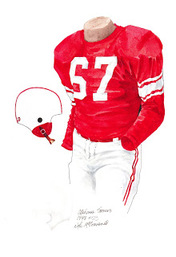
This painting honors the 1948 University of Oklahoma football team and #67, worn by Paul Burris. Coached by Sooner icon Bud Wilkinson and co-captained by Wade Walker and Homer Paine, the 1948 team went 10-1, outscoring their opponents 350-121.
The 1948 team played North Carolina in the Sugar Bowl and won 14-6. Here is how the team ranked in the AP (Associated Press) poll that year:
The 1948 team played North Carolina in the Sugar Bowl and won 14-6. Here is how the team ranked in the AP (Associated Press) poll that year:
Oklahoma Sooners - 1950
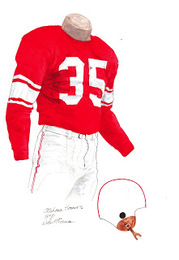
This painting honors the 1950 University of Oklahoma football team and #35, worn by Billy Vessels. Coached by Sooner icon Bud Wilkinson and co-captained by Harry Moore and Norman McNabb, the 1950 team went 10-1, outscoring their opponents 352-148, en route to the school’s first National Championship.
Oklahoma was crowned National Champions in 1950 despite the fact that they lost 13-7 to Kentucky in the Sugar Bowl. Here is how the team ranked in the UP (United Press) and AP (Associated Press) polls that year:
Billy Vessels, also known as "Curly", was a Halfback for the University of Oklahoma. His 15 touchdowns scored in the 1950 season were instrumental in helping lead the Sooners to their first National Championship. In 1952, after rushing for 1072 yards (including seven 100+ yard games) and 17 touchdowns, he won the Heisman Trophy - awarded to the outstanding intercollegiate football player in the United States.
Following his career at the University of Oklahoma, Billy was selected 1st overall in the 1953 NFL draft by the Baltimore Colts. He instead opted to join the Edmonton Eskimos of the Canadian Football League (CFL) - where he would lead the Western Conference in rushing with 926 yards and 8 touchdowns and be named the 1953 CFL Most Outstanding Player. In 1956, Billy would rejoin his original drafter, the Colts, but due to a leg injury, would only play one season in the NFL.
oklahoma sooners - 1955
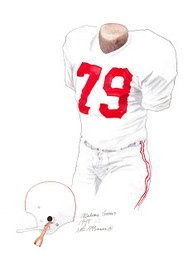
This painting honors the 1955 University of Oklahoma football team and #79, worn by All-American Guard Bo Bolinger. Coached by Sooner icon Bud Wilkinson and co-captained by Bolinger, Cecil Morris and Bob Loughridge, the 1955 team went an undefeated 11-0, en route to first of back-to-back National Championships.
Oklahoma capped off their undefeated season by beating Maryland 20-6 in the Orange Bowl. Here is how the team ranked in the UP (United Press) and AP (Associated Press) polls that year:
Oklahoma capped off their undefeated season by beating Maryland 20-6 in the Orange Bowl. Here is how the team ranked in the UP (United Press) and AP (Associated Press) polls that year:
oklahoma sooners - 1969
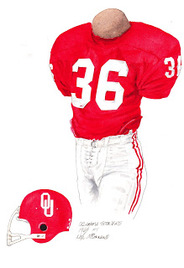
This painting honors the 1969 University of Oklahoma football team and #36, worn by Steve Owens. Coached by Chuck Fairbanks and co-captained by Owens, Steve Zabel, Jim Files and Ken Mendenhall, the 1969 team went 6-4.
Steve Owens was a Halfback for the University of Oklahoma. In a 3-year Sooner career, he scored a total of 56 touchdowns, including a 17 game streak of 100+ yards rushing, which was an NCAA record at the time. In 1969, his 1,523 yards rushing and 138 total points led the nation. In a memorable game against Oklahoma State in the ’69 season, Steve carried the ball a whopping 55 times, gaining 266 yards. That season, he was not only named unanimous All-American, but also won the Heisman Trophy - awarded to the outstanding intercollegiate football player in the United States. Following his career at the University of Oklahoma, Steve went on to play for the Detriot Lions, where unfortunately, a knee injury would end his professional football career. After football, he founded Steve Owens Insurance, based in Norman, Oklahoma and helped broadcast Sooner games on a 300-station network.
Steve Owens was a Halfback for the University of Oklahoma. In a 3-year Sooner career, he scored a total of 56 touchdowns, including a 17 game streak of 100+ yards rushing, which was an NCAA record at the time. In 1969, his 1,523 yards rushing and 138 total points led the nation. In a memorable game against Oklahoma State in the ’69 season, Steve carried the ball a whopping 55 times, gaining 266 yards. That season, he was not only named unanimous All-American, but also won the Heisman Trophy - awarded to the outstanding intercollegiate football player in the United States. Following his career at the University of Oklahoma, Steve went on to play for the Detriot Lions, where unfortunately, a knee injury would end his professional football career. After football, he founded Steve Owens Insurance, based in Norman, Oklahoma and helped broadcast Sooner games on a 300-station network.
oklahoma sooners - 1975
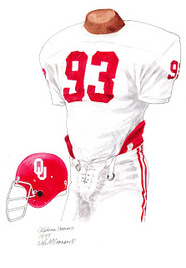
This painting honors the 1975 University of Oklahoma football team and #93, worn by Lee Roy Selmon. Coached by Sooner legend Barry Switzer and co-captained by Selmon, Dewey Selmon, Joe Washington and Steve Davis, the 1975 team went 11-1, capturing the second of back-to-back National Championships.
Oklahoma capped off their championship season by beating Michigan 14-6 in the Orange Bowl. Here is how the team ranked in the UP (United Press) and AP (Associated Press) polls that year:
Oklahoma capped off their championship season by beating Michigan 14-6 in the Orange Bowl. Here is how the team ranked in the UP (United Press) and AP (Associated Press) polls that year:
oklahoma sooners - 1985
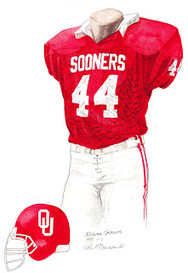
This painting honors the 1985 University of Oklahoma football team and #44, worn by Brian Bosworth. Coached by Sooner legend Barry Switzer and co-captained by Tony Casillas, Kevin Murphy and Eric Pople, the 1985 team went 11-1 and were crowned as National Champions.
Oklahoma capped off their championship season by beating Penn State 25-10 in the Orange Bowl. Here is how the team ranked in the UP (United Press) and AP (Associated Press) polls that year:
Oklahoma capped off their championship season by beating Penn State 25-10 in the Orange Bowl. Here is how the team ranked in the UP (United Press) and AP (Associated Press) polls that year:
oklahoma sooners - 1990
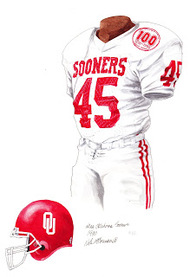
The 1990 Sooners were ineligible for post-season play because they were on probation, but they finished the season ranked #17 by the AP and went 8–3 (5–2 in the Big 8). They were coached by 2nd year coach Gary Gibbs and captained by Scott Evans, Larry Medice, Mike Sawatzky and Chris Wilson. They started the season with 5 straight wins and were ranked #4 in the nation before falling 14-13 to Texas in Dallas.
The painting of #45 honors junior linebacker Joe Bowden, who was All-American in his senior year. He went on to play 9 years on the NFL with Houston, Tennessee and Dallas. His OU records can be found here and his Wikipedia entry can be found here.
The painting of #45 honors junior linebacker Joe Bowden, who was All-American in his senior year. He went on to play 9 years on the NFL with Houston, Tennessee and Dallas. His OU records can be found here and his Wikipedia entry can be found here.
oklahoma sooners - 2000
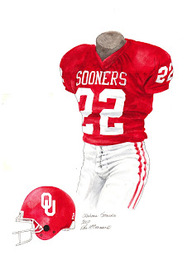
This painting honors the 2000 University of Oklahoma football team and #22, worn by Quentin Griffin. Coached by Bob Stoops and co-captained by Bubba Burcham, Rocky Calmus, Chris Hammons, Josh Heupel, Seth Littrell and Torrance Marshall, the 2000 team went 13-0 and were crowned as National Champions.
Oklahoma capped off their undefeated season by beating Florida State 13-2 in the Orange Bowl. Here is how the team ranked in the USA Today/ESPN and AP (Associated Press) polls for that season:
Oklahoma capped off their undefeated season by beating Florida State 13-2 in the Orange Bowl. Here is how the team ranked in the USA Today/ESPN and AP (Associated Press) polls for that season:
oklahoma sooners - 2003
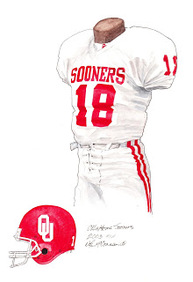
This painting honors the 2003 University of Oklahoma football team and #18, worn by Jason White. Coached by Bob Stoops, the 2003 team went 12-2 overall, including an
8-0 Conference record.
The 2003 team played LSU in the Sugar Bowl and lost 21-14. Here is how the team ranked in the USA Today/ESPN and AP (Associated Press) polls for that season:
8-0 Conference record.
The 2003 team played LSU in the Sugar Bowl and lost 21-14. Here is how the team ranked in the USA Today/ESPN and AP (Associated Press) polls for that season: